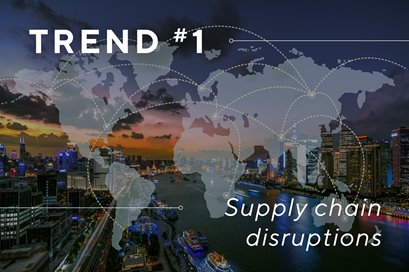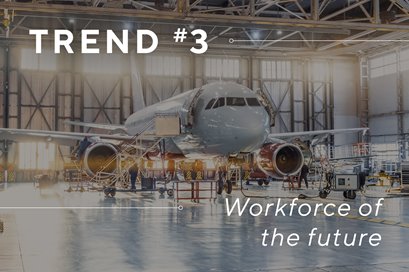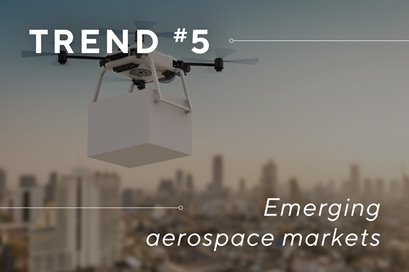Aerospace Industry Trends: Taking Flight and Staying on Course
SOURCE: Plexus Blog
The aerospace industry is finally showing signs of recovery after a few challenging years. Demand for passenger travel is picking up and leading global commercial aerospace original equipment manufacturers (OEMs) are pushing to realize unprecedented growth.
According to the airline association IATA, domestic traffic for 2022 climbed 152% versus 2021 while the international traffic recovery continues given easing travel restrictions worldwide. As a result, the industry’s outlook is promising: OEMs are estimating that global passenger traffic will return to pre-pandemic levels by the end of 2023 or early 2024. In turn, they plan to increase production ramp-ups to remediate the growing backlog.
So, are there only clear skies ahead for the aviation market? Not quite. While the recovery phase for the aviation industry has started, the pain points are still very real. And if the last few years have taught us anything, it’s caution. Here are some of the top aerospace trends and challenges that will require not only a shift in strategies, but also a closer collaboration with external partners to navigate.
Aerospace Industry Trend #1: The Continuation of supply chain disruptions
 Supply chain might be the biggest challenge for the aerospace sector in 2023. The aerospace supply chain is intensely concentrated with major players like Boeing, Lockheed Martin and Airbus placing enormous demand on the wider industry. In addition, it is very complex with multiple tiers of suppliers that provide any part of the 1 million to 5 million components needed to build a modern aircraft. In fact, an average US commercial aerospace company has more than 12,000 tier-2 suppliers. As the pandemic has shown, this complexity makes global supply chains susceptible to risks such as disruptions, bottlenecks and an overall lack of visibility beyond tier-1 suppliers. The ongoing shortages of materials and components are affecting manufacturing plans, delivery timelines and costs.
Supply chain might be the biggest challenge for the aerospace sector in 2023. The aerospace supply chain is intensely concentrated with major players like Boeing, Lockheed Martin and Airbus placing enormous demand on the wider industry. In addition, it is very complex with multiple tiers of suppliers that provide any part of the 1 million to 5 million components needed to build a modern aircraft. In fact, an average US commercial aerospace company has more than 12,000 tier-2 suppliers. As the pandemic has shown, this complexity makes global supply chains susceptible to risks such as disruptions, bottlenecks and an overall lack of visibility beyond tier-1 suppliers. The ongoing shortages of materials and components are affecting manufacturing plans, delivery timelines and costs.
On top of that, recent macroeconomics events have put additional strain on the resilience of supplier networks. According to a survey by Deloitte, inflation is keeping the entire industry on their toes. It is not only driving up costs of raw materials and components, but is also wreaking havoc with demand forecasting, inventory planning, supply chain management and cash flow. On the political stage, the invasion of Ukraine and the international sanctions against Russia have not only exacerbated fuel price volatility, but also severely disrupted supply chains for critical metals and rare earth elements. As nearly 50% of the aerospace-grade titanium is sourced from Russia, OEMs had to quickly find alternatives to ensure operability.
There is not one singular solution to tackle the supply chain challenge, only different approaches to mitigate the possible fallout following disruptions. One trend shows companies returning “home” – at least as far as production is concerned. To avoid concentration risks, companies are focusing on supply chain diversification and have entered into a renaissance period of nearshoring and re-shoring. Friend-shoring is also kicking off, focusing on countries that promise political stability and a safe haven for critical components.
While the tactics may differ, the overall goal is the same: to eliminate transportation time and create a tighter web around their supply chain. This goes back to a fundamental tenant of supply chain management. If you want to build up resilience, you have to go deep and take care of your supply base. As most disruptions usually occur beyond tier-1 suppliers, it’s the smaller suppliers that are crucial.
Aerospace Industry Trend #2: Keeping up with the digital transformation
 Leveraging AI-driven technologies to mitigate supply chain risks may be one of many digital initiatives that aerospace companies will need to invest their time and money. The tech portfolio might seem broad and overwhelming—from cloud computing and the Internet of Things (IoT) to AI/ML, digital twins, robotics and additive manufacturing (AM). Overall, the advanced—and in some cases disruptive—technologies will be necessary to automate production lines, gain profound insights into product design, improve predictive maintenance in the aftermarket service and enable sophisticated testing systems for quality management.
Leveraging AI-driven technologies to mitigate supply chain risks may be one of many digital initiatives that aerospace companies will need to invest their time and money. The tech portfolio might seem broad and overwhelming—from cloud computing and the Internet of Things (IoT) to AI/ML, digital twins, robotics and additive manufacturing (AM). Overall, the advanced—and in some cases disruptive—technologies will be necessary to automate production lines, gain profound insights into product design, improve predictive maintenance in the aftermarket service and enable sophisticated testing systems for quality management.
A smart factory approach can add much needed resilience, speed, visibility and flexibility to processes and workflows to better manage today’s shifting business environment. Companies are gradually approaching new automation technologies and testing technologies in different areas of application. However, the journey of digital transformation can also take a huge strain on a company’s resources. And while developing your own automation or AI solutions might have its perks, it requires specific technical expertise, resources and time.
Aerospace Industry Trend #3: Building the workforce of the future
 In the evolving post-COVID working world, the demand for talent feels unprecedented and the aerospace industry is no exception. In fact, it relies on a vibrant highly skilled workforce to maintain its competitive edge. And as automation and the use of advanced digital technologies are continuing to change the industry’s processes and workflows, companies grapple more than ever with a talent shortage of workers with advanced aerospace engineering skills and strong digital capabilities (e.g., data scientists, AI/ML and analytics).
In the evolving post-COVID working world, the demand for talent feels unprecedented and the aerospace industry is no exception. In fact, it relies on a vibrant highly skilled workforce to maintain its competitive edge. And as automation and the use of advanced digital technologies are continuing to change the industry’s processes and workflows, companies grapple more than ever with a talent shortage of workers with advanced aerospace engineering skills and strong digital capabilities (e.g., data scientists, AI/ML and analytics).
According to the AIA and AIAA 2022 Aerospace & Defense Workforce Study conducted by EY, the high employee turnover rate over the last few years had a major impact on manufacturing, created delays in new contracts and lowered the overall revenue outlook for 2022. Boeing projects that 610,000 new technicians will be needed over the next two decades to meet demand from fleet operators and providers of maintenance, repair, and overhaul services. Along the supply chain, nearly every element suffers from labor shortages. The suppliers worry that the human capital and working capital gaps will be exacerbated by an aggressive ramp-up of single aisles (e.g., A220, A320 and the 737 MAX).
Outsourcing aerospace engineering services might become necessary to meet the expected surge in demand. By collaborating with a product development partner in areas where aerospace companies haven’t traditionally invested in talent, they get access to a whole team of new experts with enhanced digital skills and deep technical knowledge of the industry. It is one of the best ways to expand your own team quickly while gaining a long-term partner with know-how and resources along the complete value chain.
Aerospace Industry Trend #4: Achieving Net Zero and operating sustainably
 In 2022, the aviation sector under the leadership of the UN’s International Civil Aviation Organization (ICAO) agreed to try to achieve net-zero emissions by 2050 and set targets to reduce greenhouse gas (GHG) emissions, water, waste and energy. It is an ambitious goal, considering that the industry might very well be one of the most challenging industries to decarbonize. While there is progress in reducing Scope 1 and Scope 2 emissions (made directly or indirectly during manufacturing), addressing Scope 3 emissions (made by the aircraft in flight) is more complex. Using sustainable aviation fuels (SAFs) is considered the most impactful lever in the decarbonization pathway. IATA predicts that using SAFs will contribute more than 65% of the reduction in emissions. In addition, new propulsion technologies such as electric, hydrogen and hybrid systems are viable alternatives to lower emissions and in the long term, even achieve a potential net zero emission solution.
In 2022, the aviation sector under the leadership of the UN’s International Civil Aviation Organization (ICAO) agreed to try to achieve net-zero emissions by 2050 and set targets to reduce greenhouse gas (GHG) emissions, water, waste and energy. It is an ambitious goal, considering that the industry might very well be one of the most challenging industries to decarbonize. While there is progress in reducing Scope 1 and Scope 2 emissions (made directly or indirectly during manufacturing), addressing Scope 3 emissions (made by the aircraft in flight) is more complex. Using sustainable aviation fuels (SAFs) is considered the most impactful lever in the decarbonization pathway. IATA predicts that using SAFs will contribute more than 65% of the reduction in emissions. In addition, new propulsion technologies such as electric, hydrogen and hybrid systems are viable alternatives to lower emissions and in the long term, even achieve a potential net zero emission solution.
While the development of advanced technologies will be a key driver for a “green” aviation industry, OEMs will also need to consider sustainability along the entire value chain and decarbonize their own operations, from design to manufacturing, supply chain and maintenance. Take Design for Sustainability (DfS/D4S). The European Design Council estimates that over 80% of all product-related environmental impacts are determined during the design phase. Selecting low-carbon materials (e.g., green aluminum), choosing recyclable components (Design for Recyclability), ensuring accessibility and repairability of assemblies (Design for Disassembly/Servicing) and setting up effective waste management (Design for Dematerialization) are just some potential actions OEMs can take to start decarbonizing their products.
Ultimately, these approaches are an important step toward a circular economy and might help to extend the service life of aerospace products even longer—whether through advanced data driven and AI-based maintenance and servicing or the reuse of components and materials in the sense of refurbishing and recycling.
The supply chain in and of itself can play a major role in tackling sustainability issues. According to a report by the OECD’s International Transport Forum, international trade goods transport is currently responsible for more than 7% of global CO2 emissions. By 2050, this footprint is expected to increase by a factor of 3.9. So transporting goods halfway around the world for cost reasons alone won’t simply be reasonable in the long term. Aerospace OEMs will have to make their supply chains not only resilient but also more sustainable. This includes developing a supplier base to lock in low-carbon material sources, establishing new criteria based on decarbonization capabilities of suppliers and exert their leverage as buyers to spur change among supplier networks.
Aerospace Industry Trend #5: Emerging Markets: Future Air Mobility, AAM and eVTOL
 The aerospace sector is facing growth opportunities in a couple of exciting new markets, such as space, supersonics/hypersonics and FAM (Future Air Mobility). Funding in the industry has accelerated dramatically and has found a promising candidate in Advanced Air Mobility (AAM). The technologies around automated air transportation system for passengers and cargo in urban and rural settings are expected to be the next significant game changer for mobility. In the U.S. alone, the market is estimated by Deloitte to reach $115 billion annually by 2035.
The aerospace sector is facing growth opportunities in a couple of exciting new markets, such as space, supersonics/hypersonics and FAM (Future Air Mobility). Funding in the industry has accelerated dramatically and has found a promising candidate in Advanced Air Mobility (AAM). The technologies around automated air transportation system for passengers and cargo in urban and rural settings are expected to be the next significant game changer for mobility. In the U.S. alone, the market is estimated by Deloitte to reach $115 billion annually by 2035.
Furthermore, significant innovations as well as regulatory progress are driving the development of electric vertical takeoff and landing (eVTOL) aircrafts. The Vertical Flight Society estimates that 347 worldwide entities are currently working on more than 700 eVTOL aircraft concepts and designs. And while competition is fierce, companies in this ecosystem can gain an advantage by being first movers. Legacy aerospace players will have to closely collaborate with external partners, OEMs from other industries (e.g., automotive) and FAM startups to get access to technological innovations, gain supply chain management expertise and eventually drive mass production.
The silver lining on the horizon: You don’t have to do it on your own.
No matter which aerospace trend might challenge you the most, one key to success will be to build strong partnerships to help capitalize on them. Smart outsourcing—whether it’s in the early design and development phases, manufacturing or support after your products hit the market—can add the expertise, capabilities and capacity to move faster and enter the market more competitively.
As the 2023 trends and challenges have shown, outsourcing to a partner is not merely about costs anymore. It is about a partnership that helps you to weather upcoming challenges as well as take advantage of emerging markets, disruptive technologies, and new strategies.
If you’re not sure what that kind of partnership could look like, reach out to the Plexus team. We have decades of experience helping market leaders design, manufacture and support complex aerospace products. And we can help you determine the best way forward to bring your innovation to the customers—and the passengers—who are counting on what you’ll create.











